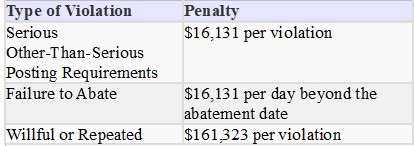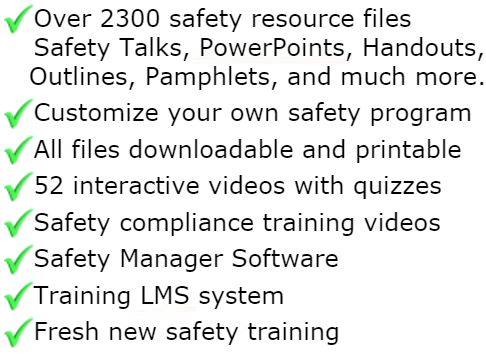
Construction Safety Programs
Construction safety covers a vast range of topics, equipment and circumstances. Construction work requires that employees from numerous contractors work together on the same construction site. And that site, situations and environment can undergo significant changes every hour and every day. Below are examples from the members library safety manual areas related to construction worksite safety.
Construction Worksite Fall Prevention
You can fall from any height and be seriously injured or killed. In the construction industry, as well as any other industry, when falls from heights happen, they're usually very serious.
Basically, fall protection is something that keeps you from falling from a certain height. Whenever you're working six or more feet high, OSHA requires fall protection.
A personal fall arrest system, generally has five components. A FULL BODY HARNESS, A LANYARD, SNAPHOOKS, AN ANCHORAGE POINT AND the fifth component is knowledge of how the system works and how to take care of the equipment.
Snaphooks connect the lanyard to your body harness. Connecting is easy by just connecting the snaphooks to the D ring on your harness. Connect them only to the D rings or anchor point. They cannot be connected directly to the harness webbing or other points... only a D ring or anchor point.
AN ANCHORAGE POINT is the place where your lanyard is attached to a solid, unmovable object which can support up to 5,000 pounds.
Employers are required to provide a training program for each employee who might be exposed to fall hazards. The program allows each employee to recognize the hazards of falling and shall train each employee in the procedures to be followed in order to minimize the hazard.
Scaffolding Worksite Safety Rules
1. Follow the manufacturer's instructions when erecting the scaffold.
2. Do not work on scaffolds outside during stormy or windy weather.
3. Do not climb on scaffolds that wobble or lean to one side.
4. Initially inspect the scaffold prior to mounting it. Do not use a scaffold if any pulley, block, hook or fitting is visibly worn, cracked, rusted or otherwise damaged. Do not use a scaffold if any rope is frayed, torn or visibly damaged.
5. Do not use any scaffold tagged "Out of Service."
6. Do not use unstable objects such as barrels, boxes, loose brick or concrete blocks to support scaffolds or planks.
7. Do not work on platforms or scaffolds unless they are fully planked.
8. Do not use a scaffold unless guardrails and all flooring are in place.
9. Level the scaffold after each move. Do not extend adjusting leg screws more than 12 inches.
10. Do not walk or work beneath a scaffold unless a wire mesh has been installed between the midrail and the toeboard or planking.
11. Use your safety belts and lanyards when working on scaffolding at a height of 10 feet or more above ground level. Attach the lanyard to a secure member of the scaffold.
12. Do not climb the cross braces for access to the scaffold. Use the ladder.
13. Do not jump from, to, or between scaffolding.
14. Do not slide down cables, ropes or guys used for bracing.
15. Keep both feet on the decking. Do not sit or climb on the guardrails.
16. Do not lean out from the scaffold. Do not rock the scaffold.
17. Keep the scaffold free of scraps, loose tools, tangled lines and other obstructions.
18. Do not throw anything "overboard" unless a spotter is available. Use the debris chutes or lower things by hoist or by hand.
19. Do not move a mobile scaffold if anyone is on the scaffold.
20. Chock the wheels of the rolling scaffold, using the wheel blocks, and also lock the wheels by using your foot to depress the wheel-lock, before using the scaffold.
CONSTRUCTION TRENCHING AND SHORING OPERATIONS
Excavations and trench cave-ins account for a growing number of fatalities and serious injuries in construction. Such accidents seldom have a single specific cause. Usually, there is a series of separate, yet related causes resulting from such factors.
A trench is referred to as a narrow excavation in which the depth is greater than the width, although the width is not greater than 15 feet. An excavation is any man made cavity or depression in the earth's surface. This can include excavations for anything from cellars to highways. Current OSHA regulations require that all excavations over 5 feet deep be sloped, shored, sheeted, braced or otherwise supported. When soil conditions are unstable, excavations shallower than 5 feet also must be sloped, supported or shored. You may have heard the term: Angle of Repose. This is a method of ensuring safety in an excavation or trench by sloping the sides of the cut, to the angel of repose which is the angel closest to the perpendicular at which the soil will remain at rest. The angle of repose varies with different kinds' of soil and must be determined on each individual project.
Whatever support system is used, workers should always apply shoring starting from the top of the trench or excavation and working down. In installing the shoring, care must be taken to place the cross beams or trench jacks in true horizontal position and to space them vertically at appropriate intervals. These braces also must be secured to prevent sliding, falling or kick-outs. Installing the shoring should closely follow the excavation work. It's dangerous to allow trenches to remain un-shored even if no work is being done in them. Dirt walls will slough off, causing dangerous overhangs. The longer a trench is left unsupported, the greater the chance of a cave in. In some cases, the contractor will have to guard against an unstable excavation bottom, such as below the water line. Sheeting may have to be driven below the bottom of such an excavation to add to the soil stability.
Shoring systems must be inspected daily by a competent person. Inspections also are required after rainstorms or any change in conditions that can increase the possibility of a cave in or slide. If dangerous ground movements are apparent, such as subsidence or tension cracks, all work in the excavation must be stopped until the problem has been corrected. In case of an emergency, workers must be able to leave the trench quickly. When employees are required to be in trenches 4 feet deep or more, adequate means of exit, such as a ladder or steps, shall be provided and located so as to require no more than 25 feet lateral travel. Ladders must be in good condition, extend from the floor of the trench to 3 feet above the top of the excavation and be secured at the top.
SUB CONTRACTOR WORKSITE SAFETY
Each company or contractor has the responsibility to make sure all employees follow safety and health rules and any specific or special rules of the jobsite.
Each contractor should have a written Injury and Illness Prevention Plan for employees that documents the job safety and health requirements and to make sure all employees are trained in these requirements. Employee safety training, regardless of job experience is mandatory. General safe work practices are important, as is specific training for those jobs with potential special hazards, such as crane operation, powder actuated tools, welding, grinding or other specific type jobs. Each employer on the job site is responsible for all training documentation, OSHA recordkeeping and other required documentation. All employers on a job site are responsible for a written and properly implemented Hazard Communications program, which includes Material Safety Data Sheets for each chemical on the worksite.
Generally, all persons shall follow safe work practices, render every possible aid to safe operations and report all unsafe conditions or practices to their foreman or site superintendent so they can be corrected. Foremen or supervisors shall insist on employees observing and obeying every applicable company, state or federal regulation and order as is necessary to the safe conduct of the work and shall take such action as is necessary to obtain compliance.
No burning, welding or other source of ignition shall be applied to any enclosed tank or vessel, even if there are some openings, until it has first been determined that no possibility of explosion exists and authority for the work is obtained from the foreman or superintendent.
Only appropriate tools for each job will be used. All tools and equipment shall be maintained in good condition. Damaged tools or equipment shall be removed from service and tagged defective and not used until repaired or replaced. Portable electric tools shall not be lifted or lowered by means of the power cord, however, they can be lifted with ropes. Electric cords shall not be exposed to damage from vehicles. Workers shall not handle or tamper with any electrical equipment, machinery, or air or water lines in a manner not within the scope of their duties, unless they have received proper training and instructions from their foreman.
All materials in the members area for this topic index

GET INSTANT ACCESS
to THE MEMBERS LIBRARY
Safety materials created by safety professionals.
Access to the Safety Manager software.
Wide variety of safety videos and courses.
**Brand New** Safety Training Management System
Pre-Made Safety Materials Ready For Use
Created by experienced safety professionals & risk consultants. Saving you time, money, and risk of injuries.
95% of the work already done.
Below are the maximum penalty amounts, with the annual adjustment for inflation, that may be assessed after Jan. 15, 2024. (See OSHA Memo, Jan. 8, 2024).

**New OSHA HEAT 90 DAY**
>>Download Free HERE<<
**New 2024 OSHA 300 Form**
>>Download Free HERE<<
**Brand New**
Free with full membership subscription
Training LMS System
Ask The Safety Consultant
Safety Equipment Deal Finder

“SafetyInfo.com is the first go-to website for safety professionals and companies to use in establishing a solid safety program"
-Mike McKenzie, Certified Safety & Health Manager (CSHM), McSafety Solutions™
Note: You must have a full subscription to the Safety Library in order to use this material. Any use outside of your organization, for resell, or without an active membership is strictly prohibited and may result in prosecution under copyright infringement laws. Please contact us first, if you would be interested in reselling or using our materials for reproduction.
Inside the Members Library
Topic Index
Accident Prevention
Air Quality
Asbestos
Bloodborne Pathogens
Boilers
Chemical Safety
Compressed Gas
Confined Space
Construction
Construction Worksite
Cranes & Slings
Driver / Fleet Safety
Drug Free Workplace
Electrical
Emergency Management
Engineering Safety
Environmental
Equipment
Ergonomics
Fall Protection
Fire Safety & Prevention
First Aid
Flammable Materials
Forklifts
Hazard Communication
Hazardous Materials
Hearing Protection
Heat Stress
Hot Work
Housekeeping
Job Safety Analysis
Laboratory
Ladders
Lead
Lockout-Tagout
Machinery & Equipment
Material Handling
MSDS (SDS)
Medical & First Aid
Occupational Health
Office Safety
Off the Job Safety
Personal Protection
Process Safety
Record Keeping
Respiratory Protection
Silica Safety
Rules & Policies
Signs & Labels
Slips, Trips & Fall
Training
Terrorism Programs
Tool Safety
Vehicle & Driver
Violence Programs
Welding & Hot Work
Training Videos
Library Index
Training Materials
Videos/Courses
Talks
Articles
PowerPoint
Handouts
Training Overheads
Quizzes
Supervisor Briefs
Management Briefs
Safety Sessions
2 Minute OSHA Safety Talks
Pamphlets
First Aid Training
Supervisor Training
Hazardous Materials
Bomb Threat
Crossword Puzzles
Biological Agents
Forms & Documents
Forms
Checklists
Audit Guides
Inspections Guides
Signs & Labels
Environmental Audit Guides
Recordkeeping - OSHA 300
Sign & Label Maker
Safety Management Resources
Safety Manuals/Written Programs
Ergonomic Programs
Emergency Plans
Process Safety Management
Construction Safety
Occupational Health
Environmental
Topic Sheets
DOT Fleet-Driver
Hazardous Materials
Chemical Safety
Drug Free Workplace
Terrorism Programs
Development Guides
Safety Manager Software
Safety References & Graphics
Technical Safety Information
Posters
Topic & Fact Sheets
Development Information
Job Specific Safety Rules
Terrorism
Calculators
Safety Comic Strips
New Safety Training System
Schedule and train your employees with our materials. Add unlimited amount of employees. Record all progress and issue certificates. For group and individual training sessions.

